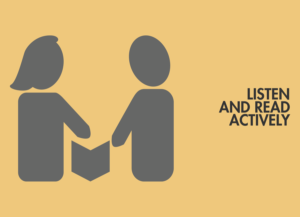I’ve been teaching for six years now. I’ve taught in different settings: a first-year college classroom, an adult ESL program in a city college, and an intensive English program. I’ve taught a variety of students and used a variety of lessons, discussions, and assignments. While I often reflect on both my practices as a teacher and my practices as a tutor separately, I find myself more often reflecting on these experiences together. I find that they truly inform one another, and reflecting on them in tandem offers opportunities for me to develop and improve as both a teacher and tutor.
I’ve also never done a listicle, so I thought why not try this out! So here goes—how excited are you that you get to read Mark Lazio’s first ever listicle!?
1) Focus on the individual’s needs.
So often as a teacher I find myself thinking about the learning outcomes of the course, material, and writing concepts. It can be easy to let the larger goals and content take away from my attention on individual students. But as a tutor, I have the advantage of almost exclusively focusing on the individual writer.

2) Set an agenda for class.
One thing my students find helpful is knowing what our daily goals are and what we’re going to do in any given class. This was something I’ve always done without really noticing it. Once again, the UCWbL’s core practice of collaboratively setting an agenda to guide your work was influencing my work as a teacher. I feel that this helps me in planning the class. Even better, going through it at the beginning of class with my students offers them the chance to question or modify the plan, creating a more engaging and active learning environment.
3) Set an agenda in feedback.
While I could go on for days about how I owe the quality of my feedback to my students to my tutoring background, I am especially thankful for the concept of setting an agenda to guide my comments. As tutors we approach feedback collaboratively, something that’s often missing in the teacher-student setting. I noticed this once in an appointment: even though we had the instructor’s prompt with explicit guidelines, when I asked the writer what they wanted to work on, I learned so much more about their feelings about their writing in this moment (see #1 above). After that appointment, I realized that insight like that doesn’t always happen as a teacher, and this experience helped me work that into my practice. I now offer students opportunities to enter into a dialogue with me about their writing/response to an assignment before I read it and provide feedback.

4) Listen actively.
As a tutor, you really can’t not listen. As a teacher, the same thing goes. But the listening skills I’ve gained from tutoring are priceless. Tutoring has helped me be a more engaged and active listener. As a tutor I can’t focus on my response; I have to truly listen to what the writer is saying and feeling. When teaching I find that it’s often tempting to slip into a more passive listening role, thinking about my response and what I’m looking for in the assignment. However, doing so misses so much of the learning process for the student.
5) Learners learn and express learning in different ways.
I’d say this is one of the most invaluable things I’ve learned as a tutor. I’ve had countless writers come in frustrated with their understanding of or ability to complete an assignment. This has shown me that just because I think something will measure and assess learning doesn’t mean it’s the only way or even the right way to do so. Furthermore, I’ve learned this lesson because I’ve worked with so many writers who clearly know the material but just can’t present it in a certain way.
These are only a few of the things I’ve seen affect my work as a teacher. There are naturally many, many, many more. Comment below with other connections you’ve noticed! (Also a HUGE shout out to Blog-o-rama’s Kate K. and Savvy L. for great brainstorming and feedback on my post! They’re also the ones who inspired my listicle approach.)
Discover more from UCWbLing
Subscribe to get the latest posts sent to your email.

